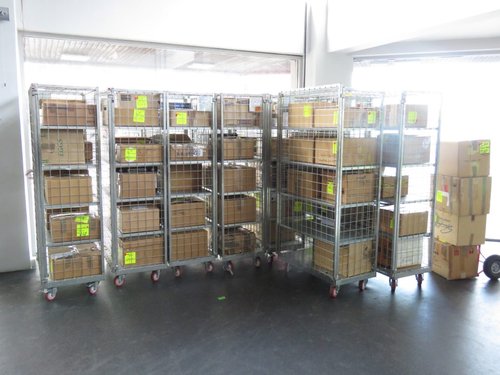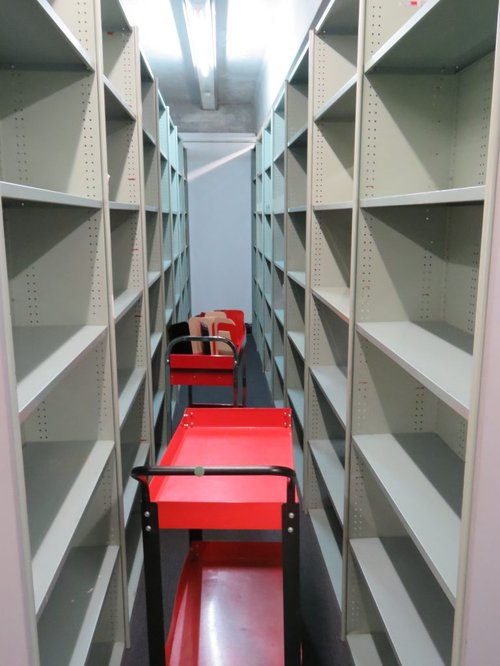
By David Klein
The COVID-19 pandemic was hugely disruptive in countless ways all around the world – but it didn’t stop a major Ngā Taonga project from being completed on time. A deadline of 28 May to fully vacate the Taranaki Street premises had been agreed with the new owners and was not altered despite lockdown regulations. Luckily, most of the planning had already been completed and the move was finished under Level 2.
Following the 2019 move of staff and operations to the National Library building, Taranaki St was used as a consolidated storage space with multiple vaults. Planning for the final move began at the end of 2019. Kate Roberts, Principal Access and Discovery Advisor, was one of the project leads. “The whole thing took a while – it’s a complex logistical exercise.”
It was also an emotional exercise – Taranaki St was home to Ngā Taonga (and its predecessor the New Zealand Film Archive before that) for 18 years. During that time thousands of people watched films in the cinema and Media Library, the café and public spaces welcomed countless visitors, and dozens of staff joined and left the organisation.
Principal Archivist Jamie Lean remembers moving into the space in 2002. “It was in a cool part of town; Cuba St was just around the corner. Ghuznee St was quite different though – there were almost no shops.”
The building had lots of room and allowed the organisation to grow. It was also not without its quirks. “The roof had a leak or two that occasionally dripped into the top floor offices, including the CEO’s”, Lean notes (the water went into the offices on the fourth floor, not the vaults). Parts of the building were reconfigured during the tenancy.
“Some floors were used as vaults at some points and offices at others. Many staff worked in different parts of the building over the years as the layouts changed.” Lean gained an especially good sense of the building as he worked through its many nooks and crannies moving material in the lead-up to the move.
Hero image: Empty shelving at Ngā Taonga on level two at Taranaki Street.

A secure move – boxes packed in to cages for the journey to Motutawa-Avalon.
While organising and working through this material led to plenty of reflection for Ngā Taonga staff, physically moving the thousands of precious film, video and paper-based records was of course no small undertaking. A huge amount of packing and checking took place. “We were almost ready to begin the move when COVID shut everything down!” laments Roberts. “So there’s been a two-month delay, but luckily we’d finished all the planning.”
When the team was able to resume work during Level 2, it involved some iconic pandemic gear: personal protective equipment (PPE). “We had staff doing lots of hard work in tricky circumstances – wearing gloves and masks and physically distancing,” reports Roberts. Up to seven staff were involved in the packing and moving and they all did well. “We’ve had some really good outcomes from what was a challenging time.” Ultimately three large truckloads of material was moved, comprising film and video items, equipment, paper records, access DVDs and 300 boxes of books from the Jonathan Dennis Library.
Despite hitting the deadline, the whole project was understandably hampered in one regard. “There were expectations that we could rationalise parts of the collections,” meaning sort and re-box them to get the most efficient arrangement for storage. “This would have been ideal, rather than having to move things twice. The time constraints though made that unrealistic”. The focus then was on packing and shifting everything. The rest of the work will now be done at the Ngā Taonga facility at Motutawa-Avalon in Lower Hutt.

Empty shelves and the trolleys that got the job done at Ngā Taonga in Taranaki Street.
Roberts explains that “it will be a big unpacking job: like a Rubix cube. Most of the material has a destination already sorted” – it’s just a matter of getting it to the right place. The majority of the material was moved to Motutawa-Avalon, with some going to other vaults at Buckle Street in Mount Cook, Wellington and North Point in Plimmerton.
With Roberts’ role involving access and discovery of the collection, she’s pleased with the outcomes this project will provide. “It means fewer storage sites and in time will give us better oversight of the collection and help with vault retrieval.”
Lean too appreciates the ways in which consolidating storage is helpful for the Archive. He does however have plenty of fond memories of events held at Taranaki St. “We had some great parties! The New Zealand Film book launch was absolutely packed and drew plenty of famous faces.” The 30th birthday of the Film Archive was another memorable occasion, as were event openings and special screenings.
One of the final acts on vacating the former premises Ngā Taonga occupied on Taranaki Street, Wellington, was to offer karakia to clear the space to keep it culturally safe for the next occupants. With Level 2 restrictions still in place, a limited number of staff were able to attend and physical distancing was employed. The karakia reflected on the taonga that had been held in the building, the events the space had hosted and the members of the Ngā Taonga whānau we had lost. Ngā Taonga Chief Executive Honiana Love said “We don’t ever sever our connection with a place we just have a new and different kind of connection. While we’re leaving this place, we never really leave – we’ll always have a connection”.
Ko te kaupapa tino whakamutunga mā mātou o Ngā Taonga, he tuku karakia kia wātea ai te whare o Te Anakura kei te huarahi o Taranaki i Te Whanganui-a-Tara.
These events and the memories of the staff who worked there will ensure that Taranaki St will always hold a special place in the cultural memory of Ngā Taonga.
Read more about the background of Te Anakura o ngā Taonga Whitiāhua, our building at 84 Taranaki Street.